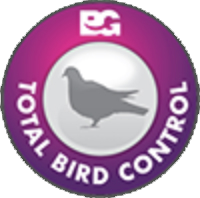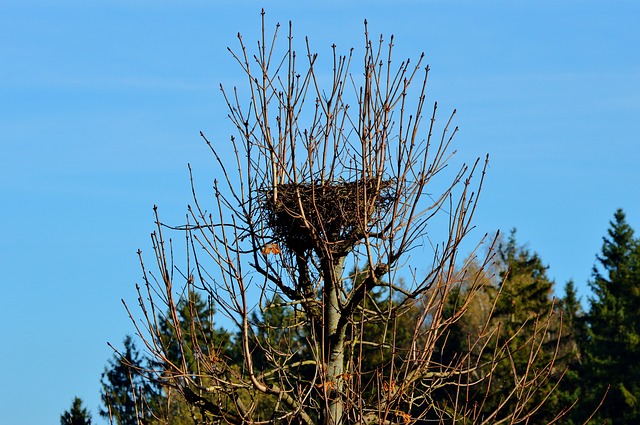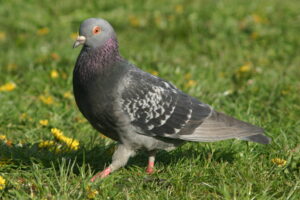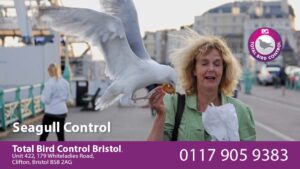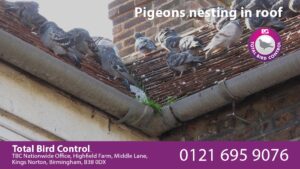A common question we get a Total Bird Control so we thought we would answer it. So, when do birds nest? The start of the nesting season coincides with the arrival of spring. Birds begin to construct their nests, flying between them in quest of supplies. Some bird species in the UK, such as the wood pigeon, nest well before spring, or perhaps all year.
It’s normal to want to do so much for birds in your yard as the nesting season progresses. Most birds have a highly energetic duty of building a nest, safeguarding the young, and keeping everyone nourished, which you can surely help them with. If you wish to aid the breeding birds in your yard, we’ve put together this guide with suggestions.
Ways to Help Nesting Birds
Keep your cat inside the house (and ask your neighbours to do the same).
Cats wreak havoc on birds, however, low-nesting birds and their youngsters are particularly vulnerable. Keep this predator far away from bird nesting areas to help the birds.
Provide nest boxes.
Providing a nestbox is a simple and apparent approach to assist nesting birds in your yard. When it comes to finding a nesting place, various species have varied needs, so do some study on the birds in your yard before deciding on a nestbox.
It may appear clear, but a correctly positioned nest box may help bridge the gap between a cavity-nesting bird’s successes or failures. Most species of birds will find it very hard in competing with starlings as well as house sparrows for some finest cavities.
Hold off trimming hedges and shrubs.
Another approach to help nesting birds is to leave nesting material in your yard, which will save them time searching for it. Human and animal hair, as well as heaps of dry branches, grass, and hay, will be enjoyed by many birds.
Many species utilize tiny hedges and bushes when building a nest. If you notice a bird constructing a nest in one of these locations on your property, you’ve got a good excuse to put off doing this yard maintenance for a month or two.
Put out pieces of dry plant material, such as grass stems, twigs, and soft leaves.
Certain leaves of grass can be made during a strong build-up for birds building weaved nests. Place the items in a tiny or simple basket. Maintain the pieces less than 2 inches to minimize the chance that birds may become caught in.
Offer short clumps of pet fur in mesh bags or put in obvious places.
If you examined a dozen bird nests, you’d find that the majority of them had animal hair. It’s soft, isolated and simple to collect. Store the fur throughout your garden for use by the birds after you groom your pet. Make sure lengthy strands are not more than two inches in sections to avoid twisting.
Put out eggshells for birds
Female birds use eggshells to replenish calcium depleted during egg formation and laying. Keep your eggshells, dry them, crush those eggshells into little bits, and distribute them on the ground in an open space.
Continue to feed high-protein foods such as mealworms, peanuts, and suet
If you don’t feed your birds, you will end up losing on some fantastic behaviour watching. Energy-dense meals such as peanuts, mealworms and suet can be very good for many birds as well as their young ones. The young birds will be able to get used to the foods from a young age.
Don’t mow meadows or brushy areas between late April and mid-August
Meadows and brushy areas should not be mowed in between April and mid-august. This will allow your birds and other wild birds to nest peacefully.
If you find a nest — stay away
If you discover a birds nest, it is best to stay away instead of lingering around. Human beings carry and leave scents everywhere, as a result, some predators may follow this trail of ascent and may end up finding the birds.
Provide water for bathing and drinking on hot days.
Water should be given to the birds all year long. However, you also need to ensure that the water provided to all these birds is very clean. The average depth of the water should be about 3 inches, not more, shallow water is good for the birds.
Nesting Cycle
Finding a place to breed
All year-round, the birds can tell the time of the season using the day length. Psychological changes are triggered in the birds if the daylight is exceeded by a certain number of hours. The birds will prepare to breed based on the changes in daylight. Other birds that are found in temperate regions, will prepare to breed so that their nestlings are born when there is a lot of food.
However, before anything else, the first thing that happens is to choose a breeding territory. Non-migratory animals can either keep their existing area or create a new one in the spring. During the spring, migratory birds begin seeking and protecting territory. Territories that are well-managed provide possible nesting locations, stable sources of food, and predator safety.
CHOOSING A MATE
Birds strive to attract mates when their habitats are being contested. Males are chosen by females for most species depending on their overall performance and vitality. Males promote their fitness as a mate by displaying colourful mating plumage during courting displays, delivering food to females, showing their nest-building skills, and chirping, thumping, or screeching throughout courtship displays. Several species’ social pair connections keep males and females together during the mating season, however, promiscuity is not unusual.
NEST BUILDING
Nests provide a secure environment for the development of eggs and young birds. Even though each species has its own distinct nest design, wild bird nests are highly varied. Some birds don’t even build nests but instead deposit their eggs in a hole in the ground. Other birds use organic elements including grass, leaves, dirt, lichen, and fur, as well as man-made items like papers, plastics, and yarn to build their nests. Need to know whether it is illegal to move a birds nest?
COPULATION AND EGG FORMATION
The internal tests of males grow in their mating season to more than 1000 in normal size due to hormonal changes. In readiness for egg fertilization and production the ovaries and oviduct of the females similarly expand in size. The male cloaca touches and throws sperm into the female cloaca during copulation. The sperm reaches the egg where it can be maintained for lengthy periods of time. If everything is going well, the sperm penetrates the ovum wall (egg) and there is fertilization. The shell of the egg grows during the first phase of embryonic development; final pigments are added
EGG LAYING
The number of eggs that a bird can lay is different for each species. There are some birds such as tropical birds that can lay 2 to 3 eggs only while other birds, particularly waterfowl species can lay 10 to 15 eggs in a single bird nesting attempt at the nesting site.
The size of the clutch also differs based on weather, availability of calcium, age of females as well as food. The shape, texture, colour, as well as size of the bird’s eggs, also varies depending on the species.
INCUBATION
To maintain the proper temperature of the eggs, the birds incubate them, this ensures that they develop very well. For most birds, incubation starts usually after laying the eggs. This also ensures that hatch at the same time. However, other birds start incubating eggs straight after laying them, as a result, such eggs can hatch at different times.
HATCHING
Songbirds and most seabirds have altricial young, which means they are blind, featherless, and defenceless when they hatch. Altricial birds can do nothing except opening their mouths and begging for foo straight after hatching. These birds will stay in the nest and depend on their parents for food and protection. During the first weeks after hatching, they are not able to maintain their body temperatures as a result, the parents need to brood the nestlings in the nesting season. After a week or so, their eyes open and they start developing feathers.
Ducks and several shorebirds are precocial animals, meaning they are born completely feathered, active, and with their eyes open. Precocial birds have an incubation period that is longer than that of altricial birds, enabling more embryo development, as a result, they have comparatively advanced motor and sensory skills upon hatching.
FEEDING THE YOUNG
In order to meet the nestling feeding requirements, parents constantly drill for food. The increased activity and the plaintive crying of nestlings might attract predators. This is quite dangerous. Usually, songbirds will generally leave the nest after two to three weeks. Other species may remain in the nest for eight to ten weeks. Precocious birds, however, don’t spend much time in the nest and often move about in looking for food next door only hours after hatching.
When do Birds leave the nest?
Most birds are only nesting once a year, however certain species such as American Robin, during one single breeding season, may have about 4 or 5 nests. Usually, hatchlings stick near to their parents for a certain time after they leave the nest (fledging). Throughout that period the nestlings need to learn to survive by themselves and are highly susceptible to hunger and predators. The first year is the most difficult; more than half of the first year in almost all bird species kill birds. However, the chance of surviving one more year improves considerably for birds that make it adults.
When do baby birds leave the nest?
Most birds will generally leave the nest two weeks after they have hatched. Their parents feed them on the ground during this critical time. Some even have the ability to return to their nests on their own.
14 More Factors That Affect Nesting Behaviors
1. Life Partners VS Promiscuous Birds
Most birds have numerous partners, while others pair for life. Whether a bird finds numerous mates or mates for life depends on the kind of bird.
Birds that stay together for life usually have small families and more elaborate mating practices. Birds with numerous partners have bigger families and shorter mating practices, whereas birds with only one mate have smaller families and short mating ritual practices. If their companion dies, birds that mate for life might find new mates. These birds undergo a developmental process that depends on the bird’s sex and species. This can all impact the exact time of nesting and egg-laying, even preventing certain birds from mating in a given year.
2. Parenting Strategy
Another element that differs sometimes a lot between species is the division of parents’ parents’ responsibilities. Some birds such as Bald Eagles or Atlantic Puffins divide their childhood tasks in equal measure.
The male and female together incubate the eggs and feed the young. They educate their young birds on how their feathers or wings may fly or hunt and clean. All tasks depend on the female, whereas the male simply focuses on the reproduction for other bird species.
These elements all have an impact on the designs you’ll see when looking for the six nesting phases. Mating and parenting habits may alter as a result of the need to provide for the offspring. Certain bird species just require more parental care and instruction than others. The American Robin, for example, can leave its nest as soon as ten days following hatching. Swans, for example, might take up to 3 or 4 months to develop.
3. Choosing The Nest Location
The location of the nest is usually decided by the female bird. Other birds, such as Bald Eagles and California Condors, though, work together to find the best place for their nests.
Hummingbirds and American Robins, for example, will seek out and build their nests on their own. This is important to know throughout the first two stages.
4. Nest Building Strategy
Based on the bird species, the nest creation can either be a single or dual procedure. This has a major influence on how the early phases of nesting are identified. Hummingbirds and Robins alone, like the above, produce their nests. Other birds cooperate as a team to build nests and burrows.
They are merely variations between species and do not affect the chance of successful hatching of their small birds. It is vital to look at distinctions between males and females, as it will enhance the accuracy of your findings.
5. Unsuccessful Clutches
An egg seizure is a collection of eggs that are laid at a moment in a clutch by birds. But it doesn’t ensure a good nest just because you witness birds mating and laying eggs. Some of the key influences on nest success are:
- Predators
- Interval of laying
- Rivals
- Egg health
- Temperature
These are important elements in the lives of birds and can affect the dates when your eggs are placed substantially.
6. Nest Predators
It’s impossible to research nesting bird behaviour without also examining nest thieves. Nest predators can have a substantial impact on whether or not birds succeed inbreeding in particular areas.
Predators that eat bird eggs often can consume an entire clutch, prompting the mother bird to lay a new nest elsewhere. Because the mother cannot defend the eggs from the heat or other predators, certain predators will devour the mother, destroying the eggs.
When birds have their nests predated by nest thieves such as ravens, raccoons, or squirrels, they have little option but to keep constructing nests and laying eggs until they eventually succeed.
7. Nest Parasites
Rather than constructing their own nests, certain birds are described as “nest parasites.” What they do is look for nests made by other birds and lay their eggs in the nests. When the eggs hatch, it can either push out all the owner’s eggs or fight for the food being delivered. As a result, the host bird’s nest was killed.
8. Temperature
Temperature fluctuations might also impair the clutch’s performance. Temperature fluctuations throughout the year might alter how much effort is necessary to maintain the proper egg temperature, leading egg-laying to occur earlier or later. Birds attempt to maintain the ideal balance by covering the eggs or giving warmth from their own bodies. However, the health of the eggs might be harmed in severe temperature circumstances.
Extreme temperatures can also impact the availability of food and the readiness of birds to reproduce. Spring’s warmth and wetness will encourage flowers and plants to blossom, attracting insects and fruits as food sources for birds.
9. Egg Health
Another element that has a substantial influence on the well-being of a clutch of eggs is the general health of the eggs. Not all eggs are healthy when they are laid. Some of the fledglings may be sick or perish during development. If the illness is infectious, it has the potential to spread to other eggs and destroy them.
Alternatively, a mother bird may notice one egg is dead or sick and abandon the entire clutch. As a result, the healthy eggs perish as well. Agriculture chemicals are another factor that can affect the health of the eggs.
10. Laying Intervals
A laying interval is basically the time when the nesting season starts and when they’re young become self-sufficient. It denotes the window period for a specific bird species to deposit eggs throughout its nesting season.
Other birds are just can develop considerably faster than others, or can tolerate higher stress throughout development, resulting in lengthier laying periods. Several nests are more frequent in birds with prolonged laying intervals.
11. Multiple Clutches
As previously stated, certain birds can only lay a single clutch over their whole laying time, whereas others lay multiple clutches.
There might be a variety of causes for this, including the following: Many mates, intervals in laying eggs, clutch replacements, location and so on.
Is it, for instance, because these birds just lost a previous clutch? Was it caused by a predator? Has the weather been unusually chilly recently?
Could it be because their last litter was a huge success and the kids have already flown the nest. These sorts of inquiries can aid you in deepening your comprehension and identifying tiny patterns that might otherwise go missed.
12. Location & Local Conditions
The number of clutches a bird may successfully lay in a year is influenced by its location. The number of food and nesting supplies varies dramatically with altitude, resulting in areas of greater or reduced potential. Birds in colder regions will have more failed clutches owing to a higher death rate, whereas birds in warmer climes will have lower death rates. More replacement clutches are placed as a result of the greater mortality rate. Birds lay eggs at different times of the year depending on where they are in the world.
13. Food Availability
Bird mating cycles are influenced by the amount of available food. Before looking for a partner, birds will wait until there are adequate food sources available. They must maintain themselves alive for the energy and time required to mate, as well as feed their spouse and offspring.
14. Day Length
Even the length of the day has an impact on the length of the mating window. Birds with longer days have a larger window of opportunity each day to obtain food, mate, and create nests for their eggs. The hormones that encourage mating in birds are similarly affected by the duration of the day.
How do you know if a bird is nesting?
A bird that is nesting can give out a number of signs such as destructive behaviour, staying fixated on a spot that does not have food and producing some additional or extra noises in the background.
How long do birds nest for?
Several songbirds are ready to leave their nests after two or three weeks. Other species, like raptors, may remain in the nest for up to 8 weeks.
How many times a year do birds lay eggs
Although most birds only nest once a year, certain species, such as the American Robin, can have as many as four or five nests in a single mating season.
